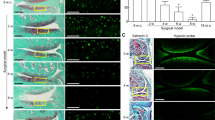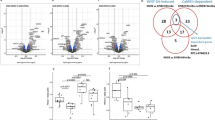Abstract
We have previously shown that functional inactivation of hypoxia-inducible factor-1α (HIF-1α) in growth-plate chondrocytes will dramatically inhibit anaerobic energy generation and matrix synthesis. Using immunohistochemistry, we have now analyzed the spatial distribution of HIF-1α and its target genes in normal cartilage and in cartilage from knee joints with osteoarthritis. We detected HIF-1α and its target genes in both types of cartilage. In cartilage from joints with osteoarthritis, the number of HIF-1α-, Glut-1-, and PGK-1-stained chondrocytes increased with the severity of osteoarthritis. Activated matrix synthesis and strongly decreased oxygen levels are hallmarks of osteoarthritic cartilage. Thus, we assume that chondrocytes are depending on the adaptive functions of HIF-1α in order to maintain ATP levels and thereby matrix synthesis during the course of osteoarthritis.
Résumé
Nous avons montré précédemment que l’inactivation du facteur de l’hypoxie 1-α (HIF-1α) dans les chondrocytes du cartilage de conjugaison inhibe très nettement la génération d’énergie anaérobie et la synthèse de la matrice. Utilisant l’immuno-histochimie nous avons analysé la distribution spatiale de HIF-1, et ses gène- cibles dans le cartilage normal et dans le cartilage d’articulations avec arthrose. Nous avons détecté des HIF-1α et ses gène-cibles dans les deux types de cartilage. Dans le cartilage arthrosique le nombre de chondrocytes marqués HIF-1α, Glut-1 et PGK-1 a augmenté avec la sévérité de l’arthrose. La synthèse de la matrice activée et le niveau d’oxygène fortement diminué sont des caractéristiques du cartilage arthrosique. Donc nous supposons que les chondrocytes dépendent de la fonction adaptative de HIF-1 pour maintenir le niveau d’ATP et de cette façon la synthèse de la matrice pendant l’évolution de l’arthrose.

Similar content being viewed by others
References
Aigner T, Zien A, Gehrsitz A, Gebhard PM, McKenna L (2001) Anabolic and catabolic gene expression pattern analysis in normal versus osteoarthritic cartilage using DNA-array technology. Arthritis Rheum 44:2777–2789
Chang H, Shyu KG, Wang BW, Kuan P (2003) Regulation of hypoxia-inducible factor-1alpha by cyclical mechanical stretch in rat vascular smooth muscle cells. Clin Sci (Lond) 105:447–456
Cramer T, Yamanishi Y, Clausen BE et al (2003) HIF-1alpha is essential for myeloid cell-mediated inflammation. Cell 112:645–657
Dumond H, Presle N, Terlain B et al (2003) Evidence for a key role of leptin in osteoarthritis. Arthritis Rheum 48:3118–3129
Grosfeld A, Andre J, Hauguel-De Mouzon S, Berra E, Pouyssegur J, Guerre-Millo M (2002) Hypoxia-inducible factor 1 transactivates the human leptin gene promoter. J Biol Chem 8:42953–42957
Grosfeld A, Zilberfarb V, Turban S, Andre J, Guerre-Millo M, Issad T (2002) Hypoxia increases leptin expression in human PAZ6 adipose cells. Diabetologica 45:527–530
Hashimoto S, Takahashi K, Amiel D, Coutts RD, Lotz M (1998) Chondrocyte apoptosis and nitric oxide production during experimentally induced osteoarthritis. Arthritis Rheum 41:1266–1274
Ivan M, Kondo K, Yang H et al (2001) HIFalpha targeted for VHL-mediated destruction by proline hydroxylation: implications for O2 sensing. Science 292:464–468
Jung YJ, Isaacs JS, Lee S, Trepel J, Neckers L (2003) IL-1beta-mediated up-regulation of HIF-1alpha via an NFkappaB/COX-2 pathway identifies HIF-1 as a critical link between inflammation and oncogenesis. FASEB J 17:2115–2117
Lund-Olesen K (1970) Oxygen tension in synovial fluids. Arthritis Rheum 13:769–776
Mankin H, Dorfman H, Lippiello L, Zarins A (1971) Biochemical and metabolic abnormalities in articular cartilage from osteoarthritic human hips. II. Correlation of morphology with biochemical and metabolic data. J Bone Joint Surg Am 53:523–537
Olney RC, Tsuchiya K, Wilson DM et al (1996) Chondrocytes from osteoarthritic cartilage have increased expression of insulin-like growth factor I (IGF-I) and IGF-binding protein-3 (IGFBP-3) and -5, but not IGF-II or IGFBP-4. J Clin Endocrinol Metab 81:1096–1103
Pfander D, Cramer T, Deuerling D, Weseloh G, Swoboda B (2000) Expression of thrombospondin-1 and its receptor CD36 in human osteoarthritic cartilage. Ann Rheum Dis 59:448–454
Pfander D, Cramer T, Schipani E, Johnson RS (2003) HIF-1alpha controls extracellular matrix synthesis by epiphyseal chondrocytes. J Cell Sci 116:1819–1826
Pfander D, Kobayashi T, Knight M et al (2004) Deletion of Vhlh in chondrocytes reduces cell proliferation and increases matrix synthesis during growth plate development. Development 131:2497–2508
Pfander D, Kortje D, Zimmermann R et al (2001) Vascular endothelial growth factor in articular cartilage of healthy and osteoarthritic human knee joints. Ann Rheum Dis 60:1070–1073
Pfander D, Swoboda B, Kirsch T (2001) Expression of early and late differentiation markers (proliferating cell nuclear antigen, syndecan-3, annexin VI, and alkaline phosphatase) by human osteoarthritic chondrocytes. Am J Pathol 159:1777–1783
Pufe T, Petersen W, Tillmann B, Mentlein R (2001) The splice variants VEGF121 and VEGF189 of the angiogenic peptide vascular endothelial growth factor are expressed in osteoarthritic cartilage. Arthritis Rheum 44:1082–1088
Pullig O, Weseloh G, Gauer S, Swoboda B (2000) Osteopontin is expressed by adult human osteoarthritic chondrocytes: protein and mRNA analysis of normal and osteoarthritic cartilage. Matrix Biol 19:245–255
Richardson S, Neama G, Philipps T et al (2003) Molecular characterization and partial cDNA cloning of facilitative glucose transporters expressed in human articular chondrocytes; stimulation of 2-desoxyglucose uptake by IGF-1 and elevated MMP-2 secretion by glucose deprivation. Osteoarthr Cartil 11:92–101
Schipani E, Ryan HE, Didrickson S, Kobayashi T, Knight M, Johnson RS (2001) Hypoxia in cartilage: HIF-1alpha is essential for chondrocyte growth arrest and survival. Genes Dev 15:2865–2876
Schneider U, Miltner O, Thomsen M, Graf J, Niethard F (1996) Intraartikuläre Sauerstoffpartialdruckmesung unter funtionellen Bedingungen. Z Orthop 134:422–425
Semenza GL (2001) Hif-1, o(2), and the 3 phds. how animal cells signal hypoxia to the nucleus. Cell 107:1–3
Semenza G, Wang G (1992) A nuclear factor induced by hypoxia via de novo protein synthesis binds to the human erythropoitein gene enhancer at a site required for transcriptional activation. Mol Cell Biol 12:5447–5454
Silver IA (1975) Measurement of pH and ionic composition of pericellular sites. Philos Trans R Soc Lond B Biol Sci 271:261–272
Stokes DG, Liu G, Coimbra IB, Piera-Velazquez S, Crowl RM, Jimenez SA (2002) Assessment of the gene expression profile of differentiated and dedifferentiated human fetal chondrocytes by microarray analysis. Arthritis Rheum 46:404–419
Studer R, Jaffurs D, Stefanovic-Racic M, Robbins PD, Evans CH (1999) Nitric oxide in osteoarthritis. Osteoarthr Cartil 7:377–379
Swoboda B, Pullig O, Kirsch T, Kladny B, Steinhäuser B, Weseloh G (1998) Increased content of type VI collagen epitopes in human osteoarthritic cartilage. Quantitation by inhibition-ELISA. J Orthoptera Res 16:96–99
Urban JP (1994) The chondrocyte: a cell under pressure. Br J Rheumatol 33:901–908
Von der Mark K, Kirsch T, Nerlich A et al (1992) Type X collagen synthesis in human osteoarthritic cartilage. Arthritis Rheum 35:806–811
Acknowledgements
This work was supported in part by the Ministry of Research (IZKF-Erlangen, D5) and by a grant from the Deutsche Forschungsgemeinschaft (PF 383/4).
Author information
Authors and Affiliations
Corresponding author
Rights and permissions
About this article
Cite this article
Pfander, D., Cramer, T. & Swoboda, B. Hypoxia and HIF-1α in osteoarthritis. International Orthopaedics (SICOT) 29, 6–9 (2005). https://doi.org/10.1007/s00264-004-0618-2
Received:
Accepted:
Published:
Issue Date:
DOI: https://doi.org/10.1007/s00264-004-0618-2




